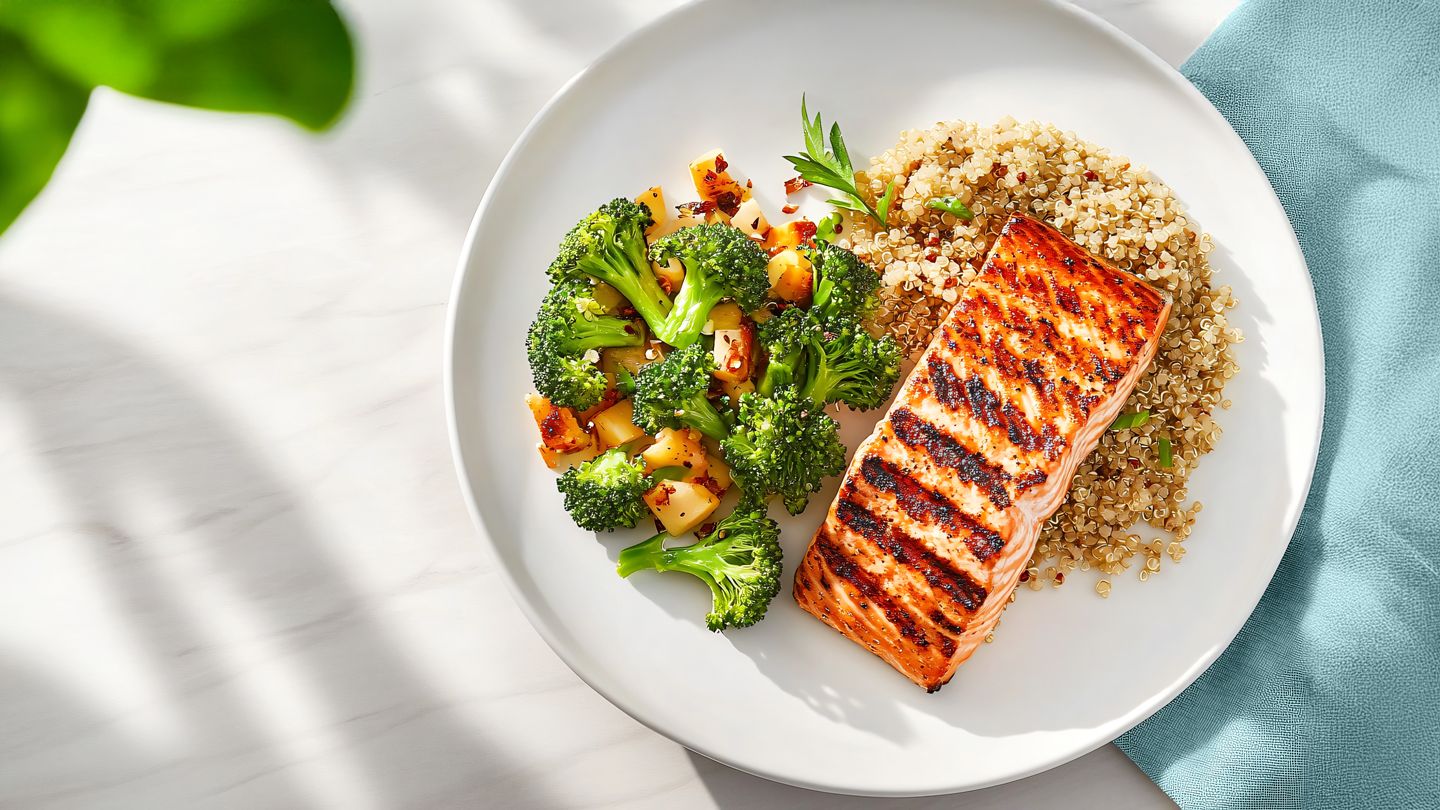A high-protein diet is a popular eating plan that emphasizes increasing your consumption of protein-rich foods while limiting carbohydrates and fat. Widely adopted in the fitness industry and by those looking to lose weight, a high-protein diet aims to support muscle development, satiety, and weight loss goals.
How Does the High-Protein Diet Work? How It Works Advocates of high-protein diets claim they reduce your appetite, boost your metabolism, and help you lose weight quickly. “Protein should be a critical part of any diet,” says Aimée José, RN, CDCES , a registered nurse in the San Diego area. Protein is digested more slowly than carbohydrates, helping you feel fuller and boosting metabolism as a result. It’s also vital for maintaining muscle mass . Increasing your protein consumption while decreasing your carbohydrate intake can support weight loss goals, too, reducing your body’s insulin needs and encouraging it to burn more body fat for energy, says José. Recommended sources of high-quality dietary protein include:e60dc2a1-f33c-4a05-9b50-8e3e8e5976295bc5a9f9-ec69-41e0-9b4e-38c26b01ad74 Poultry (skinless chicken and turkey) Fish and seafood Eggs Low-fat dairy Tofu and tempeh Legumes and beans Nuts and seeds Quinoa and amaranth Red meats, which are high in saturated fat, and heavily processed meats like bacon and sausage, which are high in sodium, should be consumed only in moderation.
A high-protein diet can be approached in several ways, according to José. For example, high-protein, low-carb diets, such as the ketogenic diet and the Atkins diet , reduce carbohydrate intake significantly while increasing protein consumption to maintain energy and muscle mass. Meanwhile, high-protein, plant-based diets emphasize the consumption of plant-derived protein sources like legumes, soy, nuts, seeds, and whole grains while avoiding or minimizing animal-derived foods.
Potential Health Benefits of the High-Protein Diet Benefits A high-protein diet can support your health in various ways, including: Muscle growth and maintenancee60dc2a1-f33c-4a05-9b50-8e3e8e59762921bd1c25-2c77-4642-bad0-cef2192e2666 Weight loss and fat losse60dc2a1-f33c-4a05-9b50-8e3e8e597629913e1def-2b85-429a-8ba2-1ac293cb3daf Improved satiety and reduced overall calorie intakee60dc2a1-f33c-4a05-9b50-8e3e8e5976296c3b252a-5210-4222-9795-8c64d821e0b2 Blood sugar stabilization and improved metabolic healthe60dc2a1-f33c-4a05-9b50-8e3e8e5976299d58dc83-88d9-4c38-bf0a-5dcc8c0faf2e Reduced triglyceridese60dc2a1-f33c-4a05-9b50-8e3e8e597629a04e71e9-8694-42d6-9bb8-1c8345b1e659
Can the High-Protein Diet Lead to Weight Loss? Weight Loss High-protein diets can support weight loss, promoting fat loss while preserving lean body mass. All weight loss involves at least some muscle loss. Prioritizing protein in your diet can reduce and prevent this muscle loss when you’re working to lose weight.e60dc2a1-f33c-4a05-9b50-8e3e8e59762983c36834-4aa4-4be7-8454-c0befff0fe20 Protein also requires more energy to digest and metabolize than dietary fat and carbohydrates, a quality known as thermic effect. This metabolic boost can help your body burn more calories overall, contributing to weight loss goals.e60dc2a1-f33c-4a05-9b50-8e3e8e597629c6355352-3694-4dde-80d9-ca0ca2040bfa Additionally, protein-rich foods are more satisfying, leaving you feeling full for longer than fats or carbohydrates. This effect is partly caused by protein’s effect on the hormones glucagon-like peptide-1 (GLP-1), cholecystokinin (CCK), and peptide YY (PYY), which signal satiety and reduce overall calorie consumption.e60dc2a1-f33c-4a05-9b50-8e3e8e5976297f3666ae-42ea-47cb-9a16-c90598e98448 “Eating more protein can definitely help you feel satisfied for longer after eating, which means you’re less likely to snack after lunch, and you’ll eat fewer calories throughout the day,” says Ben Tzeel, RD, CDCES , the founder of Your Diabetes Insider . Tzeel says other critical components of a successful high-protein diet for weight loss include: Calorie Deficit Your overall calorie consumption is key to effective weight management. Regular Exercise Both aerobic (cardio) and anaerobic (strength training) exercise support a healthy weight. Dietary Fiber Prioritize whole foods while reducing processed foods to up your fiber consumption . Adequate Hydration D rink plenty of water daily. “Protein is part of the bigger picture when it comes to weight loss and health,” says Tzeel. “It’s a very important part, but it’s not everything.”
Are There Any Disadvantages to the High-Protein Diet? Disadvantages While high-protein diets can offer several benefits for weight loss and muscle maintenance, there are a few potential drawbacks to consider before giving it a try. A high-protein diet may: Lead to nutrient deficiencies, if plant-based and fiber-rich foods are neglectede60dc2a1-f33c-4a05-9b50-8e3e8e597629902db764-2499-456f-9220-2ed49bd1ef71 Cause constipation as a result of low fiber intake, according to José Increase the risk of heart disease and certain cancers, due to overconsumption of red and processed meatse60dc2a1-f33c-4a05-9b50-8e3e8e597629b3fb8c57-0d2b-4a3a-a2eb-02d93bf75ffc Strain kidney function in individuals with preexisting kidney diseasee60dc2a1-f33c-4a05-9b50-8e3e8e5976292a129a44-0ff8-4d47-bbc0-8c8a3bf27bd8 “Any diet restricting carbohydrate consumption should be approached with fiber in mind,” says José. “There are plenty of low-carb vegetables you could include, particularly dark, leafy salad greens, to ensure you’re getting fiber and vitamins that you can’t get from any protein source.” Consult your healthcare provider before you try a high-protein diet, especially if you’ve been diagnosed with any stage of kidney disease or other kidney condition.
A Detailed High-Protein Diet Food List Food List To help you get started, here’s a closer look at which foods to focus on, and which to avoid, when following a high-protein diet. Top 10 Foods to Eat Skinless chicken breast Salmon Low-fat Greek yogurt Eggs Tofu Lentils Quinoa Low-fat cottage cheese Edamame Nuts and seeds Top 10 Foods to Limit or Avoid Sugary snacks and candy White bread and refined grains Sugar-sweetened beverages Fried foods Baked goods made with white flour Processed deli meats Full-fat dairy with added sugars High-sugar breakfast cereals Soda and energy drinks Packaged frozen meals
High-Protein Diet Shopping List Here are the foods every high-protein diet beginner needs to add to their grocery list, according to Tzeel.ProteinsChicken breastBeansEggsCanned tunaTofuProduceSpinachBroccoliBerriesBell peppersMushroomsGrainsQuinoaWhole-grain breadBrown riceOatsBarleyDairyGreek yogurtCottage cheesePart-skim mozzarella cheeseParmesan cheeseSoy milkCondimentsOlive oilMustardLow-sodium soy sauceHummusHot sauceDrinksWaterHerbal teaSparkling waterUnsweetened protein shakesCold brew coffee
A 7-Day High-Protein Diet Sample Menu Sample Menu Here’s a sample menu, designed in collaboration with Tzeel, showing what a week of eating might look like on a 2,000-calorie high-protein diet.
How to Get Started With a High-Protein Diet: 5 Beginner Tips Get Started Before you dive headfirst into a high-protein diet, Tzeel recommends getting organized and thinking through some of the common pitfalls. 1. Start Simple Begin by incorporating one high-protein food into every meal, such as eggs at breakfast or tofu at lunch. Start small instead of going overboard. You don’t need an “all or nothing” approach for the diet to be worthwhile and beneficial. 2. Plan Ahead Batch-cook protein sources like grilled chicken or tofu to make assembling high-protein meals easier throughout the week. You can precook your protein and store it in the freezer as well to ensure it stays fresh. (Don’t forget seasonings for plenty of fun flavor variety.) 3. Monitor Your Fiber Don’t let constipation become a side effect of your high-protein diet journey. Be sure to eat plenty of fiber-rich fruits, vegetables, and whole grains alongside your protein choices. If you’re trying to reduce your carbohydrate intake, aim for lots of leafy greens, onions, and nonstarchy options like broccoli, cabbage, and cauliflower. 4. Hydrate Well Water is a critical component of any healthy diet plan. If you’re having trouble getting enough water each day, use reminders in your phone or a calendar to track your water intake. You can also hit your hydration goal with healthy alternatives like herbal tea, fruit-infused water, and sparkling water. 5. Be Smart When Dining Out You can enjoy a night out while still adhering to your diet plan. Choose grilled chicken or salmon, keep sugary sauces on the side for light dipping, and swap fries or bread for the seasonal vegetable option.
The Takeaway A high-protein diet can support weight loss goals, manage appetite, boost metabolic function, and preserve lean muscle mass. If you eat more protein while reducing your carbohydrate intake you’ll lower your body’s insulin needs and encourage it to burn more body fat for energy. Since protein-rich foods are more satisfying, a high-protein diet can leave you feeling full for longer after meals, curbing extra snacking and reducing overall calorie consumption. When eating a high-protein diet, aim to consume up to 30 percent of your daily calories from high-quality protein sources such as poultry, seafood, tofu, and legumes, pairing them with leafy greens and fiber-rich, nonstarchy vegetables to meet your body’s nutritional needs.
Resources We Trust Cleveland Clinic: Best and Worst Sources of ProteinHarvard Health Publishing: When It Comes to Protein, How Much Is Too Much?American Heart Association: Protein and Heart HealthMayo Clinic: Are You Getting Enough Protein?American Diabetes Association: Protein Food for Diabetes
Read the full article here
Leave a comment




